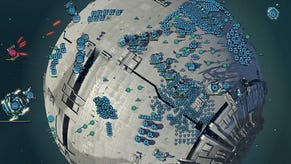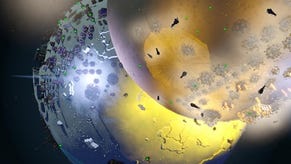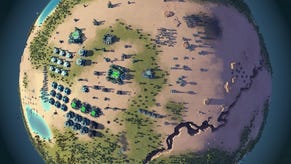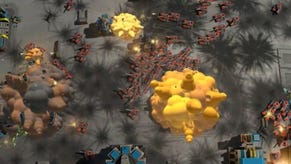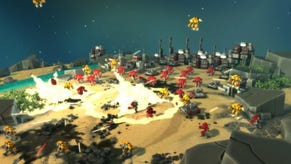Skynet Versus Cthulhu: Human Resources
The Pop Culture Apocalypse
Human Resources has one of the finest elevator pitches I've ever heard. The Singularity comes to pass, the machines rise, and humanity awakens a host of Lovecraftian horrors on the same day. It's a tale of duelling apocalypses. Skynet vs Cthulhu, with humanity caught in the middle. The Kickstarter page has just gone live for Uber's strategy followup to Planetary Annihilation, and I spoke to design director John Comes and art director Nate Simpson to learn about the end of everything.
Before getting into the nitty-gritty of the strategic apocalypse, it's important to note a couple of things right off the bat. The team for Human Resources is not the team that created and will continue to work on Planetary Annihilation. This is a separate project with separate staff, although they'll benefit from having the former game's engine ready to use. With its planet-smashing tech, it's an ideal fit for ending worlds.
And the other thing to wrap your head around before going any further is directly related to the ending of worlds. You won't get to John Connor the heck out of this situation. You won't be playing as the remnants of our race, trying to survive the clash of Machine and mi-go. Your task will be to destroy everything as one of the insurmountable forces of doom. You'll play as either the machines or the Ancient Ones, battling to devour or cleanse the world faster than your opponents. As the name of the game suggests, humans will be the fuel for your carnage. Terrified Tiberium trunks, sheltering in cities and bases as robots pick the masonry apart and scavenge the juicy innards.
"Everytime you destroy a building, it's like a little Christmas present" Comes adds. "You don't know what will spill out but there are all kinds of goodies and bonuses available."
The initial pitch is to make a primarily multiplayer game (supporting up to eight players), with AI to skirmish against, although if the Kickstarter goes well, stretch goals for a single player campaign and possible metagame will be added. At the moment, Uber are concentrating on the balance of their two planned factions, however, and creating a flowing and cleverly competitive strategic game. Comes has a strong background in crafting RTS armies, having worked in the field since the Westwood days and bringing some C&C experience to the table.
"I tend to build from the ground-up", he says when I ask him about the process of designing a faction. I create the basic units for a faction and that gives me a number to build from - other units are on a scale based around that number. Some of the fundamental differences between the factions are designed to support different playstyles. If you want to handle lots of units at the same time, the Ancient Ones might suit you better than the Machines, which let you work with individual units more closely."
One notable difference is in the base-building and resource gathering. While Machines and Ancient Ones alike can gather humans to feed their functions, they each have a second resource unique to them. For the Machines, the resource is energy, which seems like the setup for traditional base-building, with generators, turrets and factories. That's not the case. Machine structures are mobile and can be shifted around the battlefield before deployment.
The Ancient Ones are more traditional, even though their second resource is the sanity of the remaining population. By constructing temples to channel fear and madness, they can push forward to their final victory, which involves an Elder Thing, visible in the skybox, to devour the entire shard that the forces are battling over.
I should explain shards. They're the randomly generated battlefields of Human Resources. Any given conflict might take place on a single shard or several - chunks of Earth torn out of position and suspended in the air. The humans are huddled inside their cities, although there's an ongoing conversation as to whether they might fight back under certain circumstances, and if they offer little more as a resource type than enjoyable SMASHING, they may have fulfilled their purpose.
Think Rampage or Godzilla translated into a strategy game. Cities will crumble, wreckage will be strewn across the map, and Human Resources may offer one of the most vivid depictions of a battle's aftermath that we've ever seen. The shards themselves can even be sundered by higher tier attacks, reshaping the terrain and creating new tactical possibilities as ground troops are separated from their base and clouds of flying horrors take control of the fray.
After the planet-busting of PA, I wonder if this second game of mass carnage is associated with a desire to portray destruction on a grand scale, rather than the skirmishes and base-bopping of yore. Comes has the answer.
"We're not at the point technology-wise where we can push a lot of units around, so our view is - why don't we go and do that. Not only with scale of numbers - PA had a ton of scale of numbers - but we're pushing the relative scale of units in the world a lot further with Human Resources. You have creatures that are taller than skyscrapers and a much bigger breadth of vertical scale.
"It's a technical challenge in terms of getting the animations working properly, particularly having non-robot things walking around and the melee fighitng. But the scale is to give us a really immersive feeling of...the apocalypse happening! The humans are just little specks.
I usually go back to the Minas Tirith scene in Return of the King. You have all the little Uruks but then you have the trolls and the huge mammoth beasts behind them. We're going to have units of all sizes, of all different strengths, so in a battle you'll see all of these different units involved."
Bear in mind that in the middle of all those units, there are buildings packed with humans, like spam in a can, and they are the succulent prize. It could be the grimmest of all the grimdark games that have ever grimdarked, but a glance at the screenshots should put that thought to rest. John Comes told me, "I love Planetary Annihilation and I helped out on it but after that I wanted to go for something a little more cartoony, a little less serious."
So you went for the apocalypse?
"I went for two apocalypses! Duelling apocalypses. That was Nate's idea. The backstory is that the Singularity happens and in order to stop them, scientists come up with this idea of reading from an old book and summoning the Ancient Ones to come help. But, nope, that just starts a second apocalypse."
Nate has worked in comics, one in particular that was well-known called Nonplayer, so the whole art style is his. Mixing that with an irreverent tone will work really well."
The best example of that irreverence is the current plan for the game's announcer. Rather than having the robotic precision of Planetary Annihilation's commentary, Human Resources' rounds of action might well have a traffic reporter, watching the end of the world from a helicopter. Driven mad by the presence of the Ancient Ones and the whole sorry spectacle unfolding below, he'll provide useful information peppered with updates on the traffic - "Unimaginable horrors are consuming the north of the city, so you might want to avoid heading that way if you're trying to get out of town because the highway has been completely destroyed." That sort of thing.
"You know how South Park can get away with more because of its art style?" Nate asks. "There's something that comes with that extra distance from reality that makes it much more palatable that your units are eating millions of human beings."
Comes jumps back in at this point. "It also allows us to go crazier in the future, if we want to add new factions that are different apocalypses, the style opens up the palette for what we can do. A Cabin In The Woods type of feel." It's hard to fend off the images of Ragnarok that leap to mind. "We'd love to explore all kinds of different possible endings. But no zombies." Hopefully these are IMpossible endings, but maybe Uber know something I don't.
During our conversation, I repeatedly refer to the art style as 'cartoony', which is so loose a description as to be unhelpful. I asked Simpson to elaborate.
"John has been calling it graphic novel shading. Specifically it's inspired by French comic book art, guys like Mœbius and Geof Darrow. It's called the clear line style and it avoids heavy blacks and contrast in favour of strong outlines and muted colour, which plays in our favour from a readability standpoint as well.
When you're really underway in a game, you'll have some serious ground combat going on, heavy wreckage from the cities and dozens of units moving around. You'll need to be able to identify which units do what, and who is on which side, and be able to pick them out from the background. That's so much easier in this style, so it's kind of a double-win. It looks cool and different, but it's also much more legible than a more realistic rendering style."
I'm keen to see more. The theme enables a wide variety of unit types, visually and otherwise, while allowing for easily compehensible ability sets. We know about the Singularity and Cthulhu. It really is a pop culture apocalypse and that leaves so much space for future additions. Comes, Simpson and I briefly discussed the possibility mythological and theological factions, as well more oddities from the realms of weird fiction, and vintage horror and sci-fi.
They're excited about where Human Resources might take them but, despite their belief in the design they're keeping the excitement in check, at least a little. This is Uber's second trip to the Kickstarter well and while the new team hope that the delivery of Planetary Annihilation will give people confidence in their ability to deliver this next game through crowdfunding and (more than likely) Early Access, they know that some people will ask why they need to raise funds again.
"The money from the Planetary Annihilation Kickstarter was spent on Planetary Annihilation. If we'd only made the £900,000 that was the original target, it would have been a smaller game. For Human Resources, we're building something that's much more content-rich, and that means we need lots of artists and animators. Now that we've done this once, as a studio, we know how much money we realistically need to ensure we can deliver on all of our promises. PA, at release, was as close to the original pitch as almost any other Kickstarter project - we're really proud of that. Human Resources has much more content though, which is why we've settled on the target we have. If things are moving quickly, we'll add some stretch goals."
First, they pitch the game, see if people are as interested in playing as they are in making it, and then they can start to consider other ways to end it all. For now, this is just a beginning.
There's loads of lovely hi-res concept art for units, shards and buildings hidden behind the links in the article. Enjoy!








